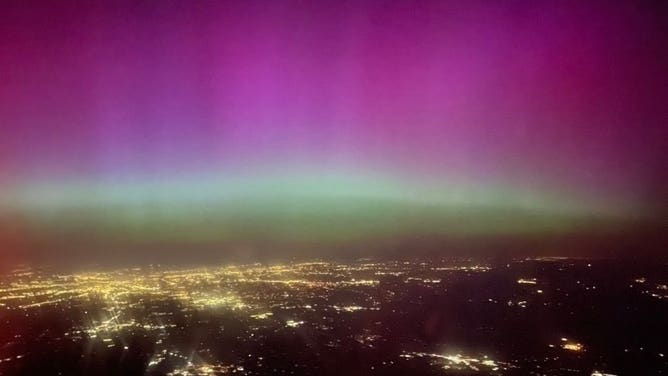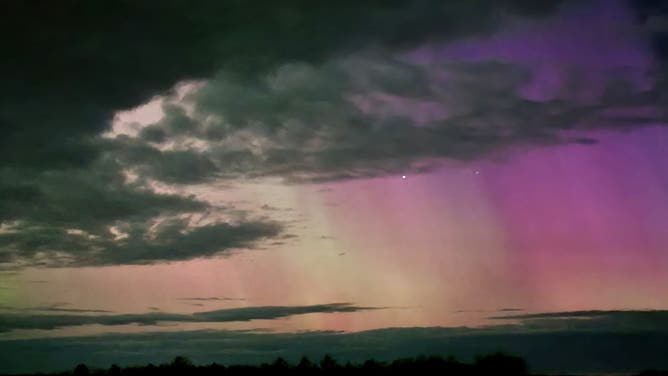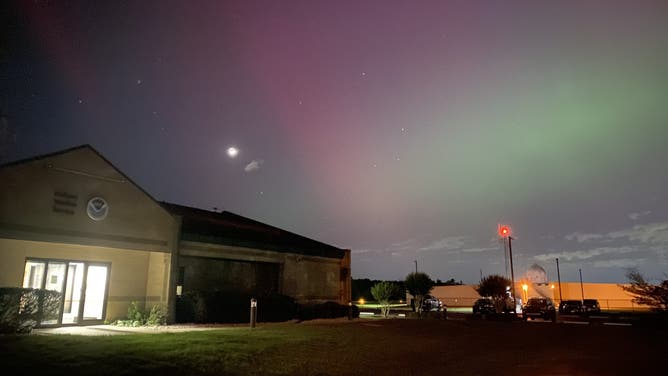‘Extreme’ solar storm triggers Northern Lights as far south as Florida Friday
Skies across the U.S. lit in a spectacular colorful glow not seen in years to decades as massive solar flares slammed into Earth on Friday, triggering "extreme" levels of geomagnetic activity. And the show may not be over for a while.
Strongest solar action in a decade impacting Earth right now
Aurora viewers will want to keep their eyes to the sky this weekend as a solar flare from the Sun is impacting Earth right now. Current forecasts indicate this storm will continue into Saturday morning across North America.
Skies across the U.S. were lit in a spectacular, colorful glow at levels not seen in years or decades as massive solar flares slammed into Earth on Friday.
Northern Light displays, typically relegated to states along the Canadian border during a typical geomagnetic storm, reached as far as the Gulf Coast Friday night, with pink, green and purple skies reported in Florida, Texas and Alabama.
The SWPC says satellites observed conditions that reached level 5 on their 5-point scale of geomagnetic activity on Friday evening, noted as an "extreme" event and the first such storm to reach that level since October 2003. While conditions have since drifted back to a level 4 storm Saturday morning, more geomagnetic activity is heading Earth's way over the weekend from additional solar flares, possibly lasting into early next week.
NOAA observed yet another massive X-class solar flare released from the Sun on Friday evening, rating it as X5.4 on their scale, among the strongest flares of recent activity.
SEE MORE: EXTREME GEOMAGNETIC STORM TRIGGERS JAW-DROPPING AURORAS AROUND THE WORLD
Aside from brilliant and widespread displays of the aurora, geomagnetic storms can impact infrastructure in near-Earth orbit and on Earth’s surface, potentially disrupting communications, the electric power grid, navigation, radio and satellite operations, the SWPC says. The last time Earth experienced a Level 5 geomagnetic event, there were power outages in Sweden and damaged transformers in South Africa.
THE HISTORY OF EARTH'S GREATEST SOLAR STORMS
"We have notified all of our infrastructure operators that we coordinate with, such as satellite operators, communication folks, and of course, the power grid here in North America," SWPC coordinator Shawn Dahl said Friday. "So they are able and prepared to take mitigation efforts as much as possible throughout this event if it should unfold to the levels that we currently are anticipating."
SpaceX's Starlink service warned on its website Saturday morning that it was experiencing "degraded service," though it didn't give further details. Yet SpaceX head Elon Musk had earlier posted on X that the Starlink satellites were under a lot of pressure due to the geomagnetic storm and were still holding up.
Massive sunspot 17 times the size of Earth creating multiple flares
Two massive sunspots have recently merged and spit out at least three X-class (largest) and several M-class (second-largest) solar flares. According to NOAA, the explosive acceleration of charged and superheated plasma, known as a coronal mass ejection or CME, speeds through space and expands.
The new sunspot is 17 times the diameter of the Earth.
"These two sunspot clusters are magnetically complex and much larger than Earth. Together they have been the source of frequent M-class flares (minor to moderate)," stated the Space Weather Prediction Center. "RGN 3664 (the combined sunspot region) continues to grow and increase in magnetic complexity and has evolved into a higher threat of increased solar flare risk."
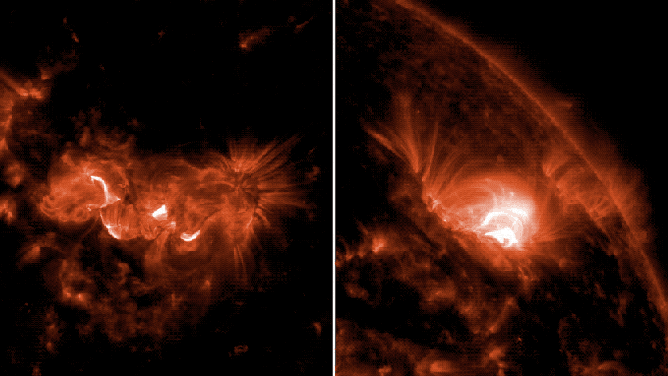
NASA’s Solar Dynamics Observatory captured these images of the solar flares — as seen in the bright flashes in the left image (May 8 flare) and the right image (May 7 flare). The image shows a subset of extreme ultraviolet light that highlights the extremely hot material in flares and which is colorized in orange.
(NASA/SDO / NOAA)
Amid the multiple solar flares, NOAA space weather forecasters have observed at least seven CMEs from the sun, with the first impacts arriving early Friday afternoon ET. Heightened solar conditions are expected to persist perhaps as long as Sunday.
"This is an unusual and potentially historic event," the SPWC stated.
Another sunspot also released strong CMEs this week and continues to be active. According to NOAA, the bulk of five CMEs will collide with Earth in a glancing blow as early as midday Friday through Sunday.
How flares can set off geomagnetic storms
"Flares are when the sun brightens, and we see the radiation, and that's kind of the muzzle flash," explained Professor Peter Becker of George Mason University in an earlier interview. "And then the cannon shot is the coronal mass ejection (CME). So, we can see the flash, but then the coronal mass ejection can go off in some random direction in space, but we can tell when they're actually going to head towards Earth. And that gives us about 18 hours of warning, maybe 24 hours of warning before those particles get to Earth and start messing with Earth's magnetic field."
SOLAR SUPERSTORM COULD ‘WIPE OUT THE INTERNET’ FOR WEEKS OR MONTHS, SCIENTIST SAYS
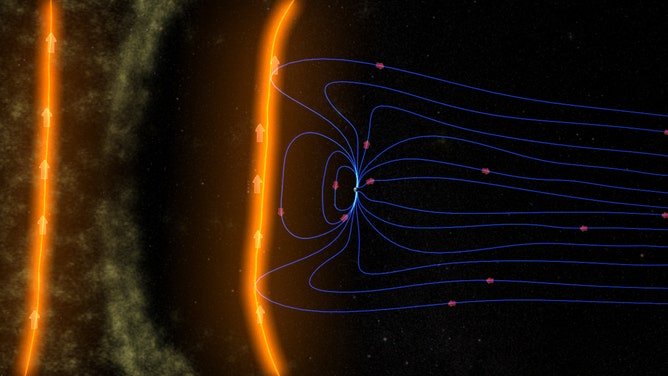
An illustration of Earth's magnetic field shielding our planet from solar particles.
(NASA/GSFC/SVS / NASA)
NOAA warns of a wide area blackout of high-frequency radio communications for hours. The geomagnetic storm could also cause widespread voltage irregularities in power systems, which trigger false alarms on security devices, cause drag on low earth orbit satellites preventing them from orienting and cause range errors and a loss-of-lock for GPS systems.
X-class solar flares are the largest explosions in the solar system. According to NASA, the biggest X-class flares can produce as much energy as 1 billion atomic bombs. M-class flares are the second-strongest flares, and they can cause minor radiation storms and harm astronauts.
Solar cycle peaking, making solar storms more plentiful
Tree rings and ice cores are evidence of much larger solar superstorms in the past.
In 1859, the great Carrington Event, generally regarded as Earth's greatest solar storm in recent history, covered nearly the entire planet in aurora. About 14,000 years ago, a solar flare, possibly hundreds of times stronger than the Carrington flare, impacted Earth.
Northern lights visible from Europe
Friday's aurora was visible across much of Europe. NOAA’s Space Weather Prediction Center classified the event as a G5, the highest level on its geomagnetic storm scale.
NOAA forecasts the current 11-year solar cycle to peak sometime in 2024 or early 2025, and solar activity is likely to remain active for the next several months or even a few years.
NOAA PREDICTS STRONGER PEAK OF SOLAR ACTIVITY IN 2024 THAN ORIGINALLY ANTICIPATED












